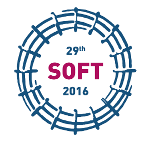Speaker
Masatoshi Kondo
(Research Laboratory for Nuclear Reactors)
Description
The development of functional layers such as the tritium permeation barrier and the anti-corrosion barrier is one of the important issues for the development of liquid breeder blanket. The functional layers with the self-healing function have been developed based on the mechanism of the oxide layer formation. The oxides of yttria (Y2O3) and zirconia (ZrO2) have an excellent chemical stability. The ceramic coating by these oxides showed the good performance as the permeation barrier for the hydrogen isotopes at high temperature. These layers can be fabricated by the pre-oxidation treatment. Therefore, these layers fabricated by the oxidation of the metals are the candidate of the self-healing type functional materials. However, the chemical stability in the liquid Pb and Pb-Li alloy are not made clear. In the same time, the methodology of the online monitoring for the time-related deterioration of these functional layers in the harsh environment must be established. It was found that the thickness and the structure of the oxide layers could be monitored using electrochemical impedance spectroscopy (EIS) in the previous study. The purpose of the present study is to investigate the chemical stability of Y2O3 and ZrO2 in liquid metal Pb and Pb-17Li. The corrosion of these layers in the liquid metals was monitored on-line by EIS method.
Pre-oxidation treatment for the rod type specimens of yttrium (Y) and zirconium (Zr) were performed at 773K for 350 hours in air environment. Then, the specimens are immersed in the liquid metals at the temperature between 773K and 873K. The impedance response for the preformed oxide layer was obtained by the EIS measurement.
Co-authors
Masatoshi Kondo
(Research Laboratory for Nuclear Reactors, Tokyo Institute of Technology, Tokyo, Japan)
Matsumura Yoshihito
(Tokai university, 4-1-1 Kitakaname, Hiratsuka-shi, Kanagawa 259-1292, Japan)
Suzuki Narumi
(Tokai university, 4-1-1 Kitakaname, Hiratsuka-shi, Kanagawa 259-1292, Japan)
Tanaka Teruya
(National Institute for Fusion Science, Toki, Gifu 502-5292 , Japan)

